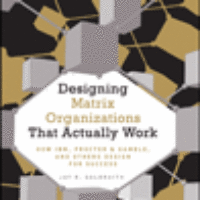Designing Matrix Organizations that Actually Work
Matrix doesn’t fail, but managers often fail at implementing the matrix. Learn how successful companies have mastered the matrix.
Matrix doesn’t fail, but managers often fail at implementing the matrix. Learn how successful companies have mastered the matrix.
Organization structures do not fail, says Jay Galbraith, but management fails at implementing them correctly. This is why, he explains, the idea that the matrix does not work still exists today, even among people who should know better. But the matrix has become a necessary form of organization in today’s business environment.
Companies now know that if they have multiple product lines, do business in multiple countries, and serve many customer segments through a variety of channels, there is no way they can avoid some kind of a matrix structure and the question most are asking is “How do we learn how to operate the matrix effectively?” In Designing Matrix Organizations That Actually Work, Galbraith answers this and other questions as he shows how to make a matrix work effectively.
From the Inside Flap
Organization structures do not fail, says Jay Galbraith, but management fails at implementing them correctly. This is why, he explains, the idea that the matrix does not work still exists today, even among people who should know better. But the matrix has become a necessary form of organization in today’s business environment. Companies now know that if they have multiple product lines, do business in multiple countries, and serve many customer segments through a variety of channels, there is no way they can avoid some kind of a matrix structure—and the question most are asking is “How do we learn how to operate the matrix effectively?” In Designing Matrix Organizations That Actually Work, Galbraith answers this and other questions as he shows how to make a matrix work effectively.
Drawing on his forty years of experience in studying and consulting with matrix organizations, Galbraith first defines what they are, tells why they are chosen, and explains why there have been failures. He provides for a complete design of the matrix organization using his Star Model, a tested framework that aligns changes in structure, processes, rewards, and people practices. The Star Model consists of policies that leaders can control and that can affect employee behavior. It shows that managers can influence performance and culture—but only by acting through the design policies that affect behavior. In order to make a matrix work, the author reveals, good relations between departments are needed, planning processes are necessary to get aligned goals, the aligned goals must go into the reward system, and people who are matrix savvy must be selected and developed. Using examples from IBM, Nokia, Procter & Gamble, and other successful corporations, he clearly illustrates the planning processes, reward systems, and human resources practices of successful implementers of the matrix.

